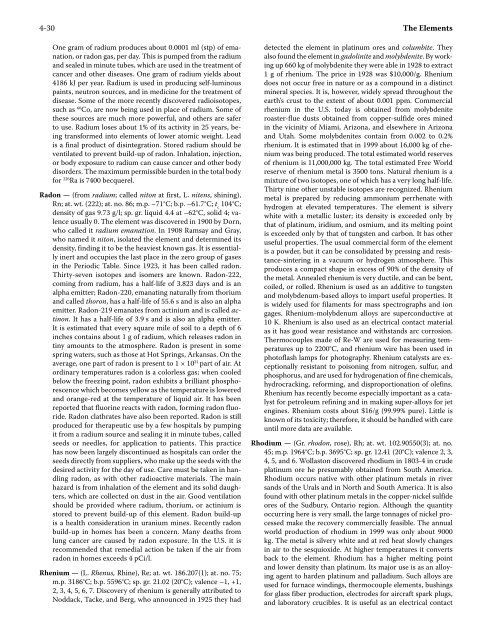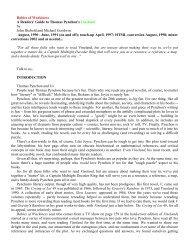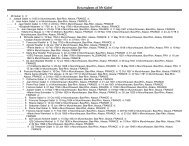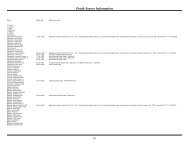CRC Handbook of Chemistry and Physics, 86th Edition
CRC Handbook of Chemistry and Physics, 86th Edition
CRC Handbook of Chemistry and Physics, 86th Edition
Create successful ePaper yourself
Turn your PDF publications into a flip-book with our unique Google optimized e-Paper software.
4-30 The Elements<br />
One gram <strong>of</strong> radium produces about 0.0001 ml (stp) <strong>of</strong> emanation,<br />
or radon gas, per day. This is pumped from the radium<br />
<strong>and</strong> sealed in minute tubes, which are used in the treatment <strong>of</strong><br />
cancer <strong>and</strong> other diseases. One gram <strong>of</strong> radium yields about<br />
4186 kJ per year. Radium is used in producing self-luminous<br />
paints, neutron sources, <strong>and</strong> in medicine for the treatment <strong>of</strong><br />
disease. Some <strong>of</strong> the more recently discovered radioisotopes,<br />
such as 60 Co, are now being used in place <strong>of</strong> radium. Some <strong>of</strong><br />
these sources are much more powerful, <strong>and</strong> others are safer<br />
to use. Radium loses about 1% <strong>of</strong> its activity in 25 years, being<br />
transformed into elements <strong>of</strong> lower atomic weight. Lead<br />
is a final product <strong>of</strong> disintegration. Stored radium should be<br />
ventilated to prevent build-up <strong>of</strong> radon. Inhalation, injection,<br />
or body exposure to radium can cause cancer <strong>and</strong> other body<br />
disorders. The maximum permissible burden in the total body<br />
for 226 Ra is 7400 becquerel.<br />
Radon — (from radium; called niton at first, L. nitens, shining),<br />
Rn; at. wt. (222); at. no. 86; m.p. –71°C; b.p. –61.7°C; t c 104°C;<br />
density <strong>of</strong> gas 9.73 g/l; sp. gr. liquid 4.4 at –62°C, solid 4; valence<br />
usually 0. The element was discovered in 1900 by Dorn,<br />
who called it radium emanation. In 1908 Ramsay <strong>and</strong> Gray,<br />
who named it niton, isolated the element <strong>and</strong> determined its<br />
density, finding it to be the heaviest known gas. It is essentially<br />
inert <strong>and</strong> occupies the last place in the zero group <strong>of</strong> gases<br />
in the Periodic Table. Since 1923, it has been called radon.<br />
Thirty-seven isotopes <strong>and</strong> isomers are known. Radon-222,<br />
coming from radium, has a half-life <strong>of</strong> 3.823 days <strong>and</strong> is an<br />
alpha emitter; Radon-220, emanating naturally from thorium<br />
<strong>and</strong> called thoron, has a half-life <strong>of</strong> 55.6 s <strong>and</strong> is also an alpha<br />
emitter. Radon-219 emanates from actinium <strong>and</strong> is called actinon.<br />
It has a half-life <strong>of</strong> 3.9 s <strong>and</strong> is also an alpha emitter.<br />
It is estimated that every square mile <strong>of</strong> soil to a depth <strong>of</strong> 6<br />
inches contains about 1 g <strong>of</strong> radium, which releases radon in<br />
tiny amounts to the atmosphere. Radon is present in some<br />
spring waters, such as those at Hot Springs, Arkansas. On the<br />
average, one part <strong>of</strong> radon is present to 1 × 10 21 part <strong>of</strong> air. At<br />
ordinary temperatures radon is a colorless gas; when cooled<br />
below the freezing point, radon exhibits a brilliant phosphorescence<br />
which becomes yellow as the temperature is lowered<br />
<strong>and</strong> orange-red at the temperature <strong>of</strong> liquid air. It has been<br />
reported that fluorine reacts with radon, forming radon fluoride.<br />
Radon clathrates have also been reported. Radon is still<br />
produced for therapeutic use by a few hospitals by pumping<br />
it from a radium source <strong>and</strong> sealing it in minute tubes, called<br />
seeds or needles, for application to patients. This practice<br />
has now been largely discontinued as hospitals can order the<br />
seeds directly from suppliers, who make up the seeds with the<br />
desired activity for the day <strong>of</strong> use. Care must be taken in h<strong>and</strong>ling<br />
radon, as with other radioactive materials. The main<br />
hazard is from inhalation <strong>of</strong> the element <strong>and</strong> its solid daughters,<br />
which are collected on dust in the air. Good ventilation<br />
should be provided where radium, thorium, or actinium is<br />
stored to prevent build-up <strong>of</strong> this element. Radon build-up<br />
is a health consideration in uranium mines. Recently radon<br />
build-up in homes has been a concern. Many deaths from<br />
lung cancer are caused by radon exposure. In the U.S. it is<br />
recommended that remedial action be taken if the air from<br />
radon in homes exceeds 4 pCi/l.<br />
Rhenium — (L. Rhenus, Rhine), Re; at. wt. 186.207(1); at. no. 75;<br />
m.p. 3186°C; b.p. 5596°C; sp. gr. 21.02 (20°C); valence –1, +1,<br />
2, 3, 4, 5, 6, 7. Discovery <strong>of</strong> rhenium is generally attributed to<br />
Noddack, Tacke, <strong>and</strong> Berg, who announced in 1925 they had<br />
detected the element in platinum ores <strong>and</strong> columbite. They<br />
also found the element in gadolinite <strong>and</strong> molybdenite. By working<br />
up 660 kg <strong>of</strong> molybdenite they were able in 1928 to extract<br />
1 g <strong>of</strong> rhenium. The price in 1928 was $10,000/g. Rhenium<br />
does not occur free in nature or as a compound in a distinct<br />
mineral species. It is, however, widely spread throughout the<br />
earth’s crust to the extent <strong>of</strong> about 0.001 ppm. Commercial<br />
rhenium in the U.S. today is obtained from molybdenite<br />
roaster-flue dusts obtained from copper-sulfide ores mined<br />
in the vicinity <strong>of</strong> Miami, Arizona, <strong>and</strong> elsewhere in Arizona<br />
<strong>and</strong> Utah. Some molybdenites contain from 0.002 to 0.2%<br />
rhenium. It is estimated that in 1999 about 16,000 kg <strong>of</strong> rhenium<br />
was being produced. The total estimated world reserves<br />
<strong>of</strong> rhenium is 11,000,000 kg. The total estimated Free World<br />
reserve <strong>of</strong> rhenium metal is 3500 tons. Natural rhenium is a<br />
mixture <strong>of</strong> two isotopes, one <strong>of</strong> which has a very long half-life.<br />
Thirty nine other unstable isotopes are recognized. Rhenium<br />
metal is prepared by reducing ammonium perrhenate with<br />
hydrogen at elevated temperatures. The element is silvery<br />
white with a metallic luster; its density is exceeded only by<br />
that <strong>of</strong> platinum, iridium, <strong>and</strong> osmium, <strong>and</strong> its melting point<br />
is exceeded only by that <strong>of</strong> tungsten <strong>and</strong> carbon. It has other<br />
useful properties. The usual commercial form <strong>of</strong> the element<br />
is a powder, but it can be consolidated by pressing <strong>and</strong> resistance-sintering<br />
in a vacuum or hydrogen atmosphere. This<br />
produces a compact shape in excess <strong>of</strong> 90% <strong>of</strong> the density <strong>of</strong><br />
the metal. Annealed rhenium is very ductile, <strong>and</strong> can be bent,<br />
coiled, or rolled. Rhenium is used as an additive to tungsten<br />
<strong>and</strong> molybdenum-based alloys to impart useful properties. It<br />
is widely used for filaments for mass spectrographs <strong>and</strong> ion<br />
gages. Rhenium-molybdenum alloys are superconductive at<br />
10 K. Rhenium is also used as an electrical contact material<br />
as it has good wear resistance <strong>and</strong> withst<strong>and</strong>s arc corrosion.<br />
Thermocouples made <strong>of</strong> Re-W are used for measuring temperatures<br />
up to 2200°C, <strong>and</strong> rhenium wire has been used in<br />
phot<strong>of</strong>lash lamps for photography. Rhenium catalysts are exceptionally<br />
resistant to poisoning from nitrogen, sulfur, <strong>and</strong><br />
phosphorus, <strong>and</strong> are used for hydrogenation <strong>of</strong> fine chemicals,<br />
hydrocracking, reforming, <strong>and</strong> disproportionation <strong>of</strong> olefins.<br />
Rhenium has recently become especially important as a catalyst<br />
for petroleum refining <strong>and</strong> in making super-alloys for jet<br />
engines. Rhenium costs about $16/g (99.99% pure). Little is<br />
known <strong>of</strong> its toxicity; therefore, it should be h<strong>and</strong>led with care<br />
until more data are available.<br />
Rhodium — (Gr. rhodon, rose), Rh; at. wt. 102.90550(3); at. no.<br />
45; m.p. 1964°C; b.p. 3695°C; sp. gr. 12.41 (20°C); valence 2, 3,<br />
4, 5, <strong>and</strong> 6. Wollaston discovered rhodium in 1803-4 in crude<br />
platinum ore he presumably obtained from South America.<br />
Rhodium occurs native with other platinum metals in river<br />
s<strong>and</strong>s <strong>of</strong> the Urals <strong>and</strong> in North <strong>and</strong> South America. It is also<br />
found with other platinum metals in the copper-nickel sulfide<br />
ores <strong>of</strong> the Sudbury, Ontario region. Although the quantity<br />
occurring here is very small, the large tonnages <strong>of</strong> nickel processed<br />
make the recovery commercially feasible. The annual<br />
world production <strong>of</strong> rhodium in 1999 was only about 9000<br />
kg. The metal is silvery white <strong>and</strong> at red heat slowly changes<br />
in air to the sesquioxide. At higher temperatures it converts<br />
back to the element. Rhodium has a higher melting point<br />
<strong>and</strong> lower density than platinum. Its major use is as an alloying<br />
agent to harden platinum <strong>and</strong> palladium. Such alloys are<br />
used for furnace windings, thermocouple elements, bushings<br />
for glass fiber production, electrodes for aircraft spark plugs,<br />
<strong>and</strong> laboratory crucibles. It is useful as an electrical contact







